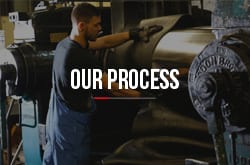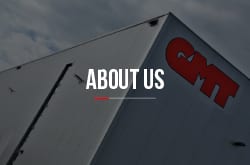Anti-vibration mounts and shock mounts incorporating both metal and rubber can be constructed either by bonding the rubber to the metal or by attaching the rubber component to the metal component through mechanical means.
Category:
Bonding Rubber to Metal
December 21st, 2023 by Ben DysonMachine Vibration Causes and Fixes
April 6th, 2023 by Steve MelvilleWhat Is Machine Vibration?
Most machinery experiences a level of vibration, and will have an expected ‘normal’ range of machine vibration while functioning. However, over time, or if something breaks or goes wrong, this level of vibration may be elevated beyond what is expected, and this can easily become dangerous to operators and the machine itself.
Rubber Injection Moulding and Compression Moulding
March 24th, 2023 by Steve MelvilleThere are many different methods used to create rubber parts and components, but some of the most popular include rubber injection moulding and rubber compression moulding.
Hand Arm Vibration Risk Assessments
March 14th, 2023 by Steve MelvilleIn 2019, Dacorum Borough Council was fined £100,000 after seven workers developed Hand Arm Vibration Syndrome. The investigation found that the council had failed to identify risks associated with the use of certain power tools and excessive use had resulted in the condition.
How to Reduce Noise and Vibrations from Wind Farms
February 16th, 2023 by Steve MelvilleIn the modern age, with our ever-increasing environmental awareness, it’s no wonder that different types of renewable energy and power generation are thriving. In the UK, one of the most popular forms of renewable energy is wind farms, both on- and off-shore, but the vibrations and noise from wind farms can be prohibitive in their building.
Ground Source or Air Source Heat Pumps – Which Is Better?
December 8th, 2022 by Steve MelvilleAir source heat pumps vs ground source heat pumps; the debate continues between these two similar but distinct technologies. Between May and July 2022, almost 903 ground and air source heat pumps were used to displace other types of home heating fuel including gas, oil and coal.
Guide to the Different Types of Rubber
October 3rd, 2022 by Steve MelvilleRubber is a unique material known for its elasticity and durability and, as such, it remains one of the most popular materials for many sectors to this day.
From brief to delivery, our experts assess our client’s individual requirements and find the best type of rubber for your application, taking into account budget, period, and, of paramount importance, functionality.
Using Rubber for Effective Anti Vibration
August 15th, 2022 by Steve MelvilleA wide variety of industries, including construction, aerospace, defence and material handling, require anti-vibration solutions to limit noise, vibrations, and shock. GMT specialises in providing anti-vibration mounts and other products to cater for each industry by offering a range of bespoke solutions to protect your equipment, vehicles, machinery and workforce. These products are a necessity for many companies, and without them, the efficiency of a company, its people and its products can be jeopardised.
How to Choose the Best Rubber Compound for Specific Applications
July 12th, 2022 by Steve MelvilleA rubber compound is produced by adding specific chemicals to raw rubber material in order to improve and alter the characteristics of the rubber for the desired use. Selecting the correct rubber compound is vitally important for any application in any industry, and the best way to do this is to select which rubber compound properties are most important.
In this post, we’re looking at some of the different properties of rubber compounds and how you can choose the right rubber compound for your applications.
The Advantages of Finite Element Analysis
April 18th, 2022 by Steve MelvilleThere are many advantages of finite element analysis as a method of product testing for businesses in many different sectors, including aerospace, construction and defence. In this post, we’re discussing the details of finite element analysis and how it works, as well as the benefits of using this testing technique over other methods.
We’ll also look at how it can be used to benefit companies and ensure the best products are being made, including how we incorporate the method with our products here at GMT.
What Is the Shore Hardness of Rubber?
December 20th, 2021 by Steve MelvilleAt GMT, we create standard and bespoke rubber bobbins, buffers and bushes, among other things, for various industries and many different uses. These products are all produced using rubber to provide flexibility. One of the key differentials for us is the Shore hardness of the rubber, but what is the Shore hardness of rubber?
This guide will provide an overview of what the Shore hardness of rubber is and how different rubber hardness scales are used to measure it.
5 Signs You Need to Replace Worn Engine Mounts
June 2nd, 2021 by Steve MelvilleAn engine mount’s primary purpose is to secure an engine into machinery and absorb any shocks and vibrations when the machinery is operating. Engine mounts and anti-vibration mounts are essential for preventing damage to the engine and improving operator comfort (where applicable). But what happens when engine mounts need replacing? And, do you know the symptoms of worn engine mounts? We answer both of these questions in this post.
A Guide on the Different Types of Motor Mounts
April 16th, 2021 by Steve MelvilleEngine mounts are an essential component of your machine or vehicle, connecting the engine to the chassis. They are designed to absorb shocks, vibration and noise during operation, which is crucial for preventing damage to both the motor and the chassis. This post discusses the different types of engine mounts available, their pros and cons, and compares solid rubber vs hydraulic motor mounts.
Step by Step Guide to Choosing Anti-Vibration Mounts
April 8th, 2021 by Steve MelvilleAs a leading specialist in rubber vibration mounts, we offer our extensive expertise using a step by step guide to help you choose the correct rubber mounts. Read on to read our easy to follow guide to choosing the best anti-vibration mount to suit you.
Natural vs Synthetic Rubber
February 15th, 2021 by Steve MelvilleBoth natural rubber and synthetic rubber hold an important place within the rubber industry, both in high demand by manufacturers. The difference between natural and synthetic rubber (in terms of how they’re made and their properties) makes both types of rubber useful for different applications. In this post, we look at natural rubber vs synthetic rubber, explaining the differences and the pros and cons of both.
Air Suspension Advantages and Disadvantages
October 21st, 2020 by Steve MelvilleAn air spring system provides a cushion between the vehicle body and wheel to reduce the vibration felt during travel. This blog will explain air spring systems and discuss air suspension advantages and disadvantages, to give you a better understanding of how they work. In particular, it will cover the benefits of air suspension when used in cars, but some of the principles carry over to heavy vehicles like trucks, tractor-trailers and passenger buses and trains.
Benefits of ISO 14001 and ISO 50001 Accreditations
June 3rd, 2020 by Steve MelvilleAt GMT, we take our environmental and energy management processes seriously, to ensure we are as environmentally and energy conscious as possible. In order for us to do this, we need to make sure the correct systems are in place so that we can manage our operations efficiently and ensure that we are mindful of our environmental impact.
ISO 14001 and ISO 50001 are two different frameworks that help with environmental and energy management systems. In this post, we describe what both of these frameworks include, as well as discussing their benefits so that you can see the mindful processes we adhere to at GMT without compromising on quality.
A Brief Guide On The Rubber Recycling Process
May 22nd, 2020 by Steve MelvilleIn the past few years, there has been a dramatic increase in the recycling of plastics and paper, with more and more people becoming aware of the positive economic effects recycling can bring. But other products can be recycled that people are not as aware of, such as rubber. Recycled rubber products can be used in many ways, but how is rubber recycled? And what are the advantages and disadvantages of recycling rubber? In this guide, we cover all of these questions and explain the rubber recycling process in more detail.
Comparing Captive and Non-Captive Parts for Mobile and Static Applications
April 15th, 2020 by Steve MelvilleWhen selecting an anti-vibration mount, it is always important to consider what would happen if the rubber was overloaded due to improper use and the rubber were to fail. In this context, it is useful to be able to categorise mounts as either captive or non-captive. The images below show the fundamental difference between the two.
An Introduction to Anti-vibration and Vibration Control Electric Car Components
March 12th, 2020 by Steve MelvilleOriginally, in July 2017 the government announced a ban on the sale of any new diesel, petrol or hybrid cars by 2040, in an effort to dramatically reduce air pollution. This comes as a strand of a larger plan to attempt to emit zero carbon by 2050. As such, as of February 2020, the banning of petrol and diesel cars by 2040 was brought forward to 2035 “if possible“.
A Short Guide on the Storage of Rubber and Rubber to Metal Components
August 8th, 2019 by Steve MelvilleMany properties of rubber make it the ideal material for anti-vibration products. To conserve these properties it’s important that the rubber is protected from environmental conditions, such as light and heat, that might otherwise degrade it. Consideration should also be given to protecting the metal that the rubber is often bonded to, as this can also be affected by these conditions.
The Growing Demand for Improved Railway Technology
September 24th, 2018 by Steve MelvilleThe Department of Transport has released a new report stating that Railways have now become the second most-used mode of transport in the UK, second only to cars. This demonstrates that, as roads have become more convoluted, people are making use of the UK’s rail service more and more. This is especially true for those living outside of a city centre but travelling into it for work. Driving into a city during rush hour normally means adding extra time onto your commute. This means that travelling by train can be a much more convenient and appealing option, but only if they are running efficiently. To keep customers happy, trains need to be consistently on time, comfortable, and able to run efficiently during peak times.
The Problem with Worn Suspension Bushes
January 17th, 2018 by Steve MelvilleSuspension bushes are a type of vibration isolator that is often made of rubber. The purpose of a suspension bush is to prevent metal-to-metal contact while still allowing for some movement. The movement is essential for allowing parts of the suspension to move freely. Although small, suspension bushes largely influence the efficiency of a vehicle, playing an important role in the safety, comfort, and handling of a vehicle. Due to the constant exposure to the elements underneath a vehicle, deterioration of suspension bushes can occur over time.
It’s therefore important to check your suspension bushes.
Levelling Feet: A Comprehensive Guide
September 5th, 2017 by Steve MelvilleLevelling feet can stabilise a wide range of machinery, with the height adjustment feature of allowing machinery to be levelled when installed on uneven ground.
There are a variety of combinations and sizes available, meaning that there is a type to suit all applications. At GMT, spindles can be combined with various types of threaded foot plate, enabling customers to specify feet to their exact requirements. The feet can also be specified to have anti-slip rubber pads. Additionally, feet with high load bearing capacity and self-aligning capabilities are available.
What is 3D Modelling?
June 27th, 2017 by Steve MelvilleHow We Use 3D Modelling
Special software allows us to plan out and accurately represent the object we have in mind. Connecting geometric shapes, curved surfaces, and lines, the 3D model gives a mathematical description of the surface of the object. Here at GMT Rubber, if standard products are not suitable to a client, we are able to produce a new design using 3D modelling. This is used in conjunction with Finite Element Analysis (FEA).
With knowledge of the client’s needs, we build a product to meet the specification whilst ensuring that the finished design is also capable of meeting service life/durability requirements.
Why Use Variable Stiffness Hydraulic Rubber Bushes?
May 23rd, 2017 by Steve MelvilleGMT’s range of technically advanced variable stiffness hydraulic axle guide bushes have already been successfully implemented for many years on major train manufacturers bogies to provide adaptive levels of stiffness for bogie axles running on tracks. Train operators are also taking advantage of the reduced wear and tear of wheels and tracks to reduce noise and energy consumption and associated track running costs.
GMT Axle And Wheelset Protectors Prove Their Worth
May 23rd, 2017 by Steve MelvilleGMT’s specialised axle and wheel set protectors for railway cars are proving to be very popular with train manufacturers and operators to avoid damage by ice and stones due to the significant reductions achieved in maintenance and repair costs. Contact GMT now to learn more about these great products.





